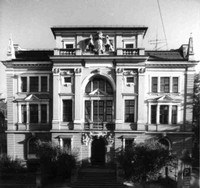History

The history of geophysics in Munich starts in 1836 with Johann von Lamont, then director of the astronomical observatory at the Bavarian Academy of Sciences. Inspired by his contacts with Alexander von Humboldt and Carl Friedrich Gauß he started observing the geomagnetic field in Munich. At the beginning these activities were sporadic, from 1840 on Lamont and his assistants regularly determined the declination and horizontal intensity of the geomagnetic field. In 1896, the geomagnetic observatory became independent from the astronomical observatory and in 1905 seismological observations commenced. The increasing industrialisation in the following time brought with it lots of electromagnetic disturbances and required to move the observatory to Maisach (1927 - 1937) and later to Fürstenfeldbruck (since 1937). One year later, the Bavarian Academy of Sciences handed over the observatory to Munich University.
The Institute of Applied Geophysics was founded in 1948. The first chair was held by Prof. Dr. Hermann Reich. In its beginnings, the institute was situated in the Deutsches Museum near the library; later on it moved to the former building of the Academy of Applied Arts at Richard-Wagner-Straße 10 (until 1971). Prof. Dr. Gustav Angenheister became chair of the institute in 1957. His successor from 1985 to 2002 was Prof. Dr. Heinrich Soffel. In 2002, the Institute of Geophysics together with the institutes of cristallography, geology, palaeontology and geography jointly formed the Department of Geo- and Environmental Sciences. This department represents one of the largest research institutions in geosciences belonging to a university in Germany. Since 2003, Prof. Dr. Hans-Peter Bunge has been chair of the Institute of Geophysics.
Nowadays, geophysics is situated in Theresienstraße 41 in direct vicinity of the well-known Munich art galleries, the Pinakotheken. Since 1984, it comprises besides the Fürstenfeldbruck observatory a laboratory for rock- and palaeomagnetism in Niederlippach near Landshut and a laboratory for rock magnetism in Garching.
Regarding teaching, the institute offers a diploma course in geophysics and educates geologists at Ludwig-Maximilians-University Munich (LMU), Munich University of Technology (TUM) and Friedrich-Alexander-University Erlangen-Nuremberg. Since the winter term of 2003/04 we have also been participating in the joint bachelor courses in geosciences offered by LMU and TUM.
